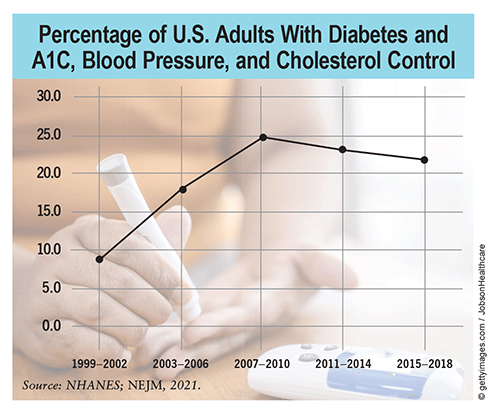Diabetes remains one of the 10 leading causes of death in the United States. Its prevalence has increased substantially over the past three decades, leading to increases in related complications as well. Optimizing control of glucose levels and associated risk factors is essential to mitigate, delay, or prevent negative health outcomes in >37 million people with diabetes nationwide. Along with lifestyle modifications, the management of diabetes should include specific goals for the “ABCs”: A1C, Blood pressure, and Cholesterol.

Adult Characteristics: Analyses of National Health and Nutrition Examination Survey (NHANES) data from 1999 to 2018 reveal key trends in various characteristics among U.S. adults with a diagnosis of diabetes. During this time, increases in the percentages of adults with diabetes aged 45 to 64 years and >65 years were reported (43.9% to 44.6% and 38.7% to 43.0%, respectively), while a decrease was noted for those aged 20 to 44 years (from 17.5% to 12.3%). The incidence among Mexican Americans also increased, from 6.8% to 10.2%, while decreases were seen among non-Hispanic white, non-Hispanic black, and other adults (61.1% to 59.8%, 16.2% to 12.9%, and 15.9% to 11.1%, respectively). In 1999, slightly more female than male adults were diagnosed with diabetes (50.5% vs. 49.5%). By 2018, the rates shifted to 54.9% for males and 45.1% for females. The percentage of adults with diabetes and obesity (BMI >30) also increased, from 51.6% to 62.0%, while the percentage of those with BMIs <30 decreased an average of 5.2% over the same period of time.
ABC Risk Factors: NHANES data also highlight trends in ABC goals. From 1999 to 2018, adults with diabetes were found to have steady increases in their control of glucose (A1C <7%; 44.0% to 50.5%), blood pressure (<140/90 mmHg; 64.0% to 70.4%), and cholesterol (non-HDL <130 mg/dL; 25.3% to 55.7%). However, glucose control and blood-pressure control were at their highest from 2007 to 2010 and 2011 to 2014 (79.4% and 74.2%, respectively). This has prompted a need to identify potential gaps in healthcare and develop targeted public-health initiatives. The percentage of adults in whom all three goals were achieved simultaneously increased by 13.2% between 1999 and 2018 and peaked at 24.9% during the 2007–2010 period.
Medication Use: Similar upward trends were reported from 1999 to 2018 for medications that lower glucose (74.1% to 82.7%), blood pressure (59.4% to 73.8%), and cholesterol (28.4% to 56.3%). Glucose-lowering and blood pressure–lowering medications peaked between 2007 and 2010 before plateauing or slightly decreasing, bringing additional attention to the potential challenges that may have been faced by individuals with diabetes over the past 10 years.
The content contained in this article is for informational purposes only. The content is not intended to be a substitute for professional advice. Reliance on any information provided in this article is solely at your own risk.
To comment on this article, contact rdavidson@uspharmacist.com.





